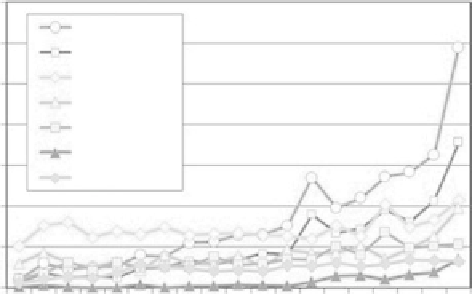Environmental Engineering Reference
In-Depth Information
Synthetic biology may also be important to developing alternative uses of ethanol from sug-
arcane. There are many possible and perhaps suitable ways to use well the available biomass for
energy generation in a broader scenario. In fact, many possible pathways to obtain biofuels may be
designed based on the available feedstock. The primary use of sucrose for ethanol production is
essentially an economical decision and the combination either sequentially or serially of alternative
processes is an option to improve feedstock for biofuels and energy production. For first-generation
biofuel, the knowledge is in place for the direct use of sugarcane syrup to produce ethanol even
when it is depleted through sugar manufacture in integrated bioethanol and sugar production units
(in this case it is postulated to be the one and half generation process). The use of lignocellulosic
material, in this case either sugarcane bagasse or microalgae from CO
2
as a feedstock, is generally
defined as second generation. On the other side, the use of the biomass gasification to further pro-
duce liquid biofuels is framed as the third generation pathway. The technology is always improving
and in the last years the learning curve has offered already a potential for short term competitive
costs for all idealized pathways. It is expected that plastics from sugarcane will be soon available
and diesel from the ethylic route will be the next option.
Sugarcane research has been increasing over the years. Figure 21.5 shows the evolution of the
number of scientific papers published annually on sugarcane-related subjects, classified according
to the country of origin. Brazil is the leader in publications, a trend that started with the public
release of the SUCEST EST sequencing data in 2001. In 2008, Brazilian publications accounted
for over half of the articles indexed by the ISI/WoS System, 22% of which were originated from
the State of São Paulo in Brazil, which also is responsible for 60% of the sugarcane production in
Brazil. Recently, Fundação de Amparo à Pesquisa do Estado de São Paulo (FAPESP), one of the
largest funding agencies in Brazil started the Bioenergy Program BIOEN (http://bioenfapesp.org)
aiming at integrating comprehensive research on sugarcane and other plants that can be used as
biofuel sources, stimulating innovative and path changing research in cooperation with research
institutions and private companies from other states of Brazil and from other countries.
Research on sugarcane aims at two broad objectives: increasing productivity and increasing
sustainability. In Brazil productivity gains have been intense, especially since the establishment
of the PROALCOOL Program in (1975) The average yield has increased from 46 to 75 t/ha,
mostly through the development of customized varieties, using classical breeding, and through
improvements in the agricultural process. As mentioned above, Paul Moore estimated from first
principles that the potential yield for sugarcane is expected to be 472 t/ha (Waclawovsky et al.
2010). Considering that yields as high as 212 t/ha have been observed there seems to be room
Sugarcane research
350
Brazil
São Paulo, Br
USA
India
Australia
China
Cuba
300
250
200
150
100
50
0
FIGure 21.5
Evolution of the number of scientific articles published annually on sugarcane, related topics.
(Data retrieved from ISI's Web of Science, www.isiknowledge.com).

